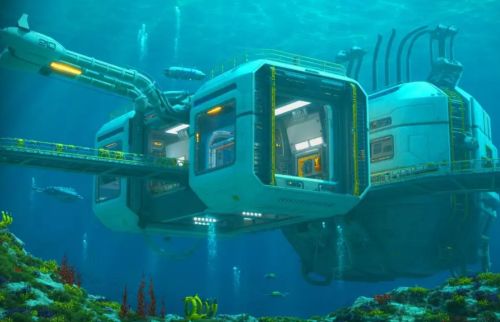

Humanity has always extended its frontiers into spaces thought unreachable, from the Arctic to the Moon. Now, the crushing depths of the ocean floor are next.

By Matthew A. McIntosh
Public Historian
Brewminate
A Vision Beneath the Waves
In an era defined by space ambitions, China has turned its gaze downward. By 2030, Beijing intends to complete a permanent research station on the seafloor, buried in the silent dark at 6,500 feet below the surface. It is projected to rival the combined complexity of three International Space Stations, a comparison meant to emphasize scale rather than simply dramatize the challenge.
The project, reported through China’s Ministry of Science and Technology, seeks to merge frontier exploration with national prestige. Much like lunar bases or Mars missions, a deep-sea facility conveys both scientific purpose and symbolic power. At that depth, human presence is impossible without a highly engineered habitat, meaning the station will largely depend on automation and remotely operated systems.
Engineering at the Limits
Building anything at 6,500 feet involves forces few people ever imagine. Pressure increases by roughly one atmosphere every 33 feet, which means the planned station will endure nearly 200 times the pressure experienced at sea level. For perspective, that is enough force to crush an unprotected submarine hull instantly.
China proposes to overcome these conditions with reinforced alloys, advanced composites, and modular design systems tested over the past decade in shorter missions. The comparison to multiple International Space Stations is not rhetorical excess: the structure is expected to host dozens of independent laboratories, energy systems, and docking hubs for submersibles.
Questions remain about sustainability. Power generation, data transmission, and long-term maintenance represent obstacles as complex as those facing space programs. Nuclear micro-reactors have been mentioned in speculative reports, though official details remain sparse. Fiber-optic tethers and relay buoys will likely provide communication links, but seawater is unforgiving, and corrosion can unravel even the most careful engineering.
Scientific Promise and Strategic Weight
Supporters emphasize the scientific potential. A seafloor base could revolutionize the study of marine biology, geology, and climate systems. From hydrothermal vents to deep-sea species adapted to crushing darkness, the station could provide unparalleled access to environments still barely understood.
Yet the ambition is not purely academic. The South China Sea, where the project is expected to be located, remains one of the most contested bodies of water on earth. Building a permanent facility there would extend China’s technological footprint and signal a deeper claim to influence over the seabed’s resources. Rare earth minerals, methane hydrates, and untapped fisheries are all part of the broader calculus.
This dual identity, research hub and geopolitical marker, cannot be disentangled. The history of great projects, from space stations to nuclear programs, suggests that scientific curiosity often travels hand in hand with national strategy.
Echoes of the Space Race
The metaphor of the deep-sea project as an underwater space station is more than convenient. It highlights the way nations have shifted their competitive frontiers. Just as the United States and the Soviet Union once raced to orbit, China is now racing toward dominance in the underexplored depths.
The International Space Station itself cost over $100 billion and relied on multinational cooperation. By contrast, Beijing appears prepared to fund and build its deep-sea complex unilaterally. That distinction underscores not only technological ambition but also political intent. A project “as complex as three ISS” is meant to communicate capability to rivals as much as it is to advance science.
Risks, Skepticism, and the Unknown
Skeptics question whether a functioning base can be completed on the timeline promised. The engineering is daunting, and costs will likely balloon. Deep-sea habitats in the past, such as the U.S. Navy’s SEALAB projects in the 1960s, demonstrated both the allure and the hazards of prolonged underwater presence. Equipment failures, accidents, and maintenance demands grow exponentially under pressure.
Others warn that secrecy surrounding the project makes it difficult to assess feasibility. Without international oversight, transparency on safety and environmental impact will be limited. Environmentalists caution that large-scale operations on the seafloor could disturb fragile ecosystems already vulnerable to human intrusion.
Still, dismissing the project outright would be premature. China has demonstrated a track record of achieving grand technical milestones after skeptics declared them improbable, from high-speed rail networks to lunar landings.
The Future Beneath Us
Whether completed in 2030 or delayed, the vision of a sprawling deep-sea research station reveals much about the trajectory of global science and power. Humanity has always extended its frontiers into spaces thought unreachable, from the Arctic to the Moon. Now, the crushing depths of the ocean floor are next.
For China, the project may be less about what happens inside the laboratories than what the structure itself represents: mastery over a domain few others dare to enter. The oceans cover more than seventy percent of the planet. To build a permanent home within them is not only an act of science but a declaration of presence. What remains to be seen is whether this presence enriches human knowledge or simply deepens the rivalries that already churn at the surface.
Originally published by Brewminate, 09.09.2025, under the terms of a Creative Commons Attribution-NonCommercial-NoDerivatives 4.0 International license.


